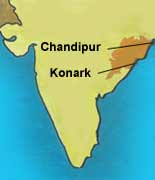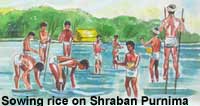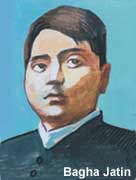
Dimdima
Online Children's Magazine from India

Dimdima
Online Children's Magazine from India

A distance of around 32km separates the Jagannath temple from the celebrated Sun Temple of Konarak. Our journey to this architectural marvel is along the picturesque Marine Drive, flanked by the blue waters of the Bay of Bengal on one side and cashew, casuarina, eucalyptus and palm trees and paddy fields on the other.
 The main occupations of the people living along this coast are fishing and growing rice. The sowing and harvesting of rice are occasions of ceremony and festivity. Shraban Purnima is a festival at the time of sowing, when boys are made to walk on stilts in the haDe that the crops would grow as high.
The main occupations of the people living along this coast are fishing and growing rice. The sowing and harvesting of rice are occasions of ceremony and festivity. Shraban Purnima is a festival at the time of sowing, when boys are made to walk on stilts in the haDe that the crops would grow as high.
 The black stone chariot temple of Surya can be seen even several miles out at sea. It is the largest temple in the country. It once stood 60m high and was an important landmark for sailors. European sailors called it the Black Pagoda to distinguish it from the white-washed temple of Jagannath in Puri, their other important landmark in the region.
The black stone chariot temple of Surya can be seen even several miles out at sea. It is the largest temple in the country. It once stood 60m high and was an important landmark for sailors. European sailors called it the Black Pagoda to distinguish it from the white-washed temple of Jagannath in Puri, their other important landmark in the region.
According to a legend, Samba, the son of Krishna and Jambavati, was stricken with leprosy. So, Krishna asked him to propitiate Surya, the healer of all diseases.
After 12 years of severe penance, Samba was cured of his illness. In gratitude, he erected a temple to Surya. He found an idol of Surya while bathing in the Chandrabhaga river by the side of the temple and installed it in the temple.
The Chandrabhaga, now just a shallow pool, lies 3 km from the temple. Pilgrims take a purificatory bath here just before sunrise on the seventh day of the waxing moon in the Hindu month of Magha (January-February).
King Languda Narashimha Deva of the Ganga dynasty is said to have built the present temple at the site of the legendary temple in the 13th century. It is believed to have taken 1200 workmen 12 years tO build it.
Legend has it that the master builder, Bisu Maharana wanted to make the temple a marvel of architecture. He was so engrossed in building it that he neglected his wife and son who lived in his native village. Meanwhile, his son Dharmapada grew up and trained to become a builder like his father. Then one day, he decided to go in search of his father.
Bisu Maharana had almost finished constructing the temple. But due to a miscalculation, he was not able to fix the crowning piece correctly on the temple. This delayed the temple's completion and angered King Narasimha. Bisu was in great distress when Dharmapada found him. Dharmapada quietly corrected the calculations and the temple was completed.
The tower no longer exists. But even without it, the temple is over 40m high. The huge stone temple was designed in the shape of a mythical chariot of the Sun god, drawn by a team of seven richly caparisoned galloping horses. The horses represent the seven days of the week. The 12 pairs of wheels on the chariot represent the 12 months or the 24 fortnights in a year. Each wheel has 16 spokes (signifying the ancient practice of dividing a day into 16 prahars) and is believed to work like a sundial casting shadows at a particular angle at each hour of the day.
For centuries the temple lay abandoned and in ruins. Its massive size attracted attention early this century and it was only when the sand and debris covering it were removed that its magnificence was revealed. The temple has now been listed as a UNESCO World Heritage Site.
A journey of a few kilometres to the north takes us to Paradip, a major port of the country. It is the first port on the east coast that was constructed after independence.
Paradip is also a pleasant beach resort with a marine promenade. Thousands of giant sea turtles come here every year from places as far off as South America to lay their eggs.
 The world's largest gathering of sea turtles takes place at the Gahirmatta Sanctuary higher up the coast.
The world's largest gathering of sea turtles takes place at the Gahirmatta Sanctuary higher up the coast.
Every year in January or early February, an estimated 10 lakh sea turtles come here to breed and nest. This includes endangered species of sea turtles like the olive ridley. Over 300,000 olive ridley females emerge for nesting along the 1Okm stretch of the beach.
Our journey further north takes us to Balasore or Baleshwar, a trading port established by the British in 1642. It was here that the great revolutionary leader,Jatindra Nath Mukherji, also known as Bagha Jatin, died after being  shot at by the British. Jatin reached Balasore in September 1915 to take delivery of arms and ammunition from the German ship Maverick, but was intercepted by the police and killed.
shot at by the British. Jatin reached Balasore in September 1915 to take delivery of arms and ammunition from the German ship Maverick, but was intercepted by the police and killed.
The beachtown of Chandipur in the district of Salasore is famous for its beach which extends more than five kilometres into the sea at low tide. At night the sand shimmers in the moonlight and Chandipur, the 'town of the silvery moon' lives up to its name.
Last updated on :9/23/2005
Dimdima is the Sanskrit word for ‘drumbeat’. In olden days, victory in battle was heralded by the beat of drums or any important news to be conveyed to the people used to be accompanied with drumbeats.
Bharatiya Vidya Bhavan
K. M Munshi Marg,
Chowpatty, Mumbai - 400 007
email : editor@dimdima.com
Bharatiya Vidya Bhavan
505, Sane Guruji Marg,
Tardeo, Mumbai - 400 034
email : promo@dimdima.com
Dimdima.com, the Children's Website of Bharatiya Vidya Bhavan launched in 2000 and came out with a Printed version of Dimdima Magazine in 2004. At present the Printed Version have more than 35,000 subscribers from India and Abroad.